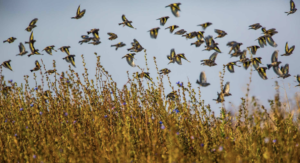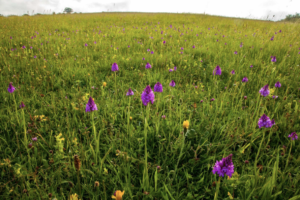Pasture Champions: Cotswold Beef and Ian Boyd
 Goldfinches and linnets
Goldfinches and linnets
About your farm – location, size, altitude, climate, soils, enterprises, organic/PfL/other status
Whittington Lodge Farm is a Cotswold Hill farm which is managed with the neighbouring Whittington Estate totalling 280 ha. It is Organic, Pasture-for-Life and Red Tractor certified. There are steep valleys and hilltops to 900 feet, a Site of Special Scientific Interest (SSSI) and a Scheduled Monument in the Roman town of Wycomb.
65 ha of Wildflower meadows were created from thin brashy arable land 15 years ago and they have now been assessed as species-rich Calcareous grassland on the Priority Habitat Inventory.
There are 30 ha of steep and heavy Permanent Pasture and 70 ha of rotated Herbal Leys as well as 50 ha of Spring Barley with over-wintered stubbles. There are also 10 ha of floristically enhanced margins, 10 ha of Wild Bird Seed Crops, 5 ha orchard and 30 ha of scrub and woodland.
The grassland is managed by a herd of 50 Pedigree Hereford cows, calves and their fattening youngstock. All beef is sold direct to customers under the brand “Cotswold Beef”.
All this is a long way from how it was farmed prior to 2005 when it was nearly all intensive arable with grain fed cattle. It has been quite a journey which required a mindset change to low input farming.
What made you think about your farm’s biodiversity?
A love of wildlife photography and the succession of environmental stewardship schemes which enabled our farm to prioritise our farmland wildlife.
How did you get started on species identification?
I had inspirational teachers at both my schools who gave me a great interest in wildlife. I was a “Gosling” at Slimbridge Wetlands Centre and did a lot of school bird ID competitions. Peter Scott was the father of a school friend and he was inspirational too.
How many species of grass are in your pasture? How do they help you combat drought or flooding?
It is not so much the species of grass that I am looking for but legumes and herbs as they are essential to the fertility on an organic farm
Our farm has 3 types of grassland.
First there are 70 ha of herbal leys that are part of an arable rotation. We sow 5 species of grass, 5 legumes and 3 species of herbs. Their drought tolerance has been very noticeable these last couple of years.
Secondly there are 30 ha of permanent pasture on heavy uneven and steep land. Now that no inorganic fertilizers are applied, the number of species is increasing and less affected by drought.
Lastly 65 ha of former arable land with thin brashy soils has been reverted to wild flower meadows which after 15 years have now been assessed and included in the Priority Habitat Inventory as species-rich calcareous grassland. These are increasingly biodiverse with 43 species recorded on the best. They are not very productive but that was never the aim. They do however provide winter grazing.
How often do you test your soil and with what?
Not often or consistently enough. Several soil tests were done 4-5 years ago, from the simpler VESS and earthworm counts to expensive soil profiles. We found that the Loss on Ignition test also cooks the calcium carbonate in our limestone soils so unrealistically high SOM are recorded. But more importantly it enabled us to formulate a rotation and management to improve our soil heath within the constraints of Organic certification (no glyphosate, so No-till is not an option) and ensuring profitability - arable options are mostly more profitable than grassland options.
We really need to be monitoring our soils more regularly though we know that the 4-5 years of mob grazed herbal leys will improve the soils, but 2-3 years of arable will have a detrimental effect.
What we need to do is reduce the arable but it pays better and the farm has commitments to an inflexible Countryside Stewardship. The hope is that the much anticipated ELMS will incentivise farms to prioritise their soils.
There are several distinct habitats across the farm:
The Wildflower meadows
 Wildflower Meadows
Wildflower Meadows
These are at their best mid-June to early July and we have several wildlife groups who come to see them.



